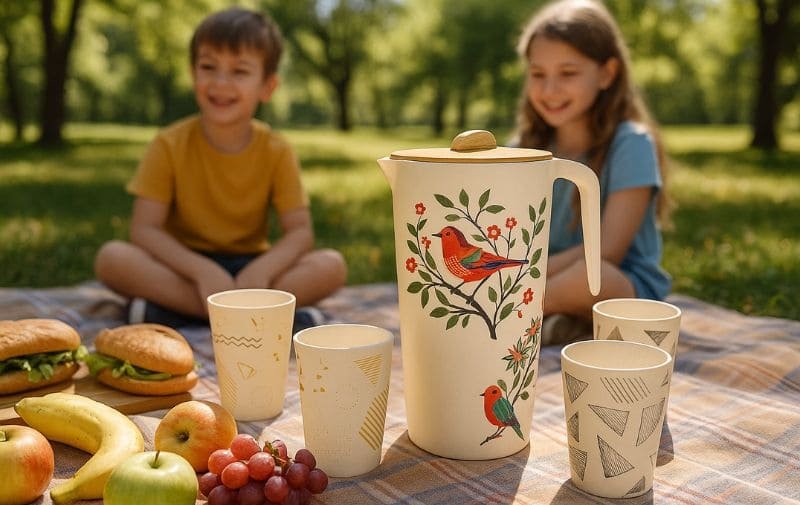A custom-printed melamine jug is more than just a container for beverages; it’s a silent ambassador for your brand. Whether sitting on a restaurant table, featured in a retail home goods collection, or as a centerpiece for an outdoor dining set, a well-designed jug speaks volumes. It conveys quality, reflects your brand’s aesthetic, and creates a high-perceived value that commodity products simply can’t match.
But how do you actually turn an idea into a physical product, manufactured overseas and delivered to your doorstep? To custom-order a melamine jug, you confirm your design (material, model, artwork), meet the MOQ (usually 3000 pcs), finalize custom printing and packaging, and arrange shipping.
This guide will walk you through the entire process, from the first crucial decisions to the final logistics, demystifying each step and providing the industry insights you need to order with confidence.
Last Updated: 21th. June 2025 | Estimated Reading Time: 9 Minutes
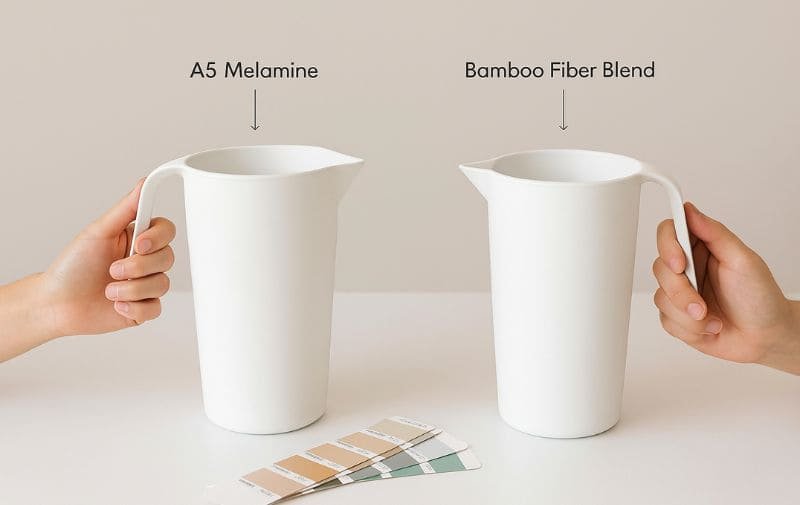
What Are Your First Big Decisions When Customizing a Jug?
Before you even ask for a price, you have to make some core decisions. These choices will define your product’s look, feel, cost, and target audience.
The first critical decisions are choosing your material (glossy A5 melamine or matte bamboo fiber) and deciding whether to use a factory’s standard mold or invest in creating your own unique shape.
This initial stage is all about laying the foundation for your product. It’s where your brand’s identity starts to take physical form. I spent a lot of time on this part, because getting it right makes everything that follows so much easier. You’re essentially deciding on the jug’s soul and its skeleton.
Your Material: The Brand’s First Handshake
The material you choose is the first thing your customer will notice. It sets the tone for their entire experience.
- A5 Melamine (100% Melamine Resin): This is the gold standard for high-quality, durable drinkware. It’s the workhorse material trusted by restaurants and premium home brands.
- Aesthetic: Offers a glossy, vibrant, porcelain-like finish. Colors print with exceptional sharpness and brightness.
- Best For: Brands that want a classic, premium feel; designs with bright, crisp colors; high-use environments like food service.
- Durability: Extremely durable, chip-resistant, and dishwasher safe.
- Bamboo Fiber (Melamine-Bonded): This is a composite material made from a mix of natural bamboo powder and melamine resin, which acts as a binder.
- Aesthetic: Features a modern, matte, and slightly textured finish. It has an earthy, organic look that is very popular.
- Best For: Brands targeting eco-conscious consumers; product lines with a natural, minimalist, or rustic aesthetic.
- Technical Detail: The patterns and colors on bamboo fiber will have a slightly more muted and textured appearance compared to A5 melamine. This is part of its unique charm.
| Feature | ✅ A5 Grade Melamine | ♻️ Bamboo Fiber (Melamine-Bonded) | Which Should You Choose? |
|---|---|---|---|
| Finish | High-gloss, vibrant, smooth | Matte, earthy, slightly textured | Choose A5 for bright pop; choose Bamboo for natural elegance. |
| Target Audience | Premium home, restaurants, classic brands | Eco-conscious, modern, minimalist brands | Match the material to your brand’s core values. |
| Color Reproduction | Extremely sharp and bright | More muted and natural | Provide Pantone codes for both, but expect different results. |
| Durability | Highest level of durability and chip resistance | Very durable, but slightly less hard than pure A5 | Both are excellent for daily use and are dishwasher safe. |
The Mold Decision: Use a Standard Shape or Create Your Own?
This is the most important decision you’ll make regarding cost versus brand uniqueness. It determines the fundamental shape of your jug.
- Option 1: Use a Standard Factory Mold (Recommended for 90% of Buyers) A reputable supplier like Duramela has a library of existing, market-proven molds for jugs (e.g., 1.3L, 1.5L) and matching cups.
- Pros: No mold fee (huge cost saving), faster production start, proven design that is balanced and pours well.
- Cons: The shape is not exclusive to your brand.
- Best For: First-time buyers, businesses on a budget, and those who want to focus their customization on the printed design rather than the shape.
- Option 2: Invest in a New, Custom Mold If your brand requires a completely unique silhouette, handle design, or spout, you will need to commission a new mold.
- Pros: Your product shape is 100% exclusive to you, creating a powerful brand asset that competitors cannot copy.
- Cons: Requires a significant upfront investment and adds to the project timeline.
- Best For: Established brands with a specific design vision, businesses that want to create a signature product line.
| Aspect | Using a Standard Mold | Creating a Custom Mold | The Bottom Line for Your Business |
|---|---|---|---|
| Upfront Cost | $0 | $900 – $1,500 USD (approx.) | Standard molds make your project immediately affordable. |
| Timeline | Production can start almost immediately. | Adds 14-21 days for mold creation and testing. | If speed-to-market is critical, use a standard mold. |
| Exclusivity | Shape is shared; uniqueness comes from your print. | Shape is your exclusive property. | A custom mold is a long-term competitive advantage. |
| Risk | Low. The mold is tested and proven. | Moderate. Requires careful design and testing. | Work with an experienced supplier to de-risk a new mold. |
How Does Your Design Actually Get Fused Onto the Jug?
Ever wonder how the beautiful, full-wrap patterns get on a melamine pitcher and stay there, even in the dishwasher? It’s not paint or a sticker.
Your custom design is printed on a special decal paper, which is then placed into the mold with raw melamine powder. Under extreme heat and pressure, the decal permanently fuses with the jug’s surface, becoming part of the product itself.
This was a “wow” moment for me. The process is ingenious and is the key to melamine’s durable, food-safe designs. Understanding this helps you provide the right kind of artwork and shows your supplier you’ve done your homework.
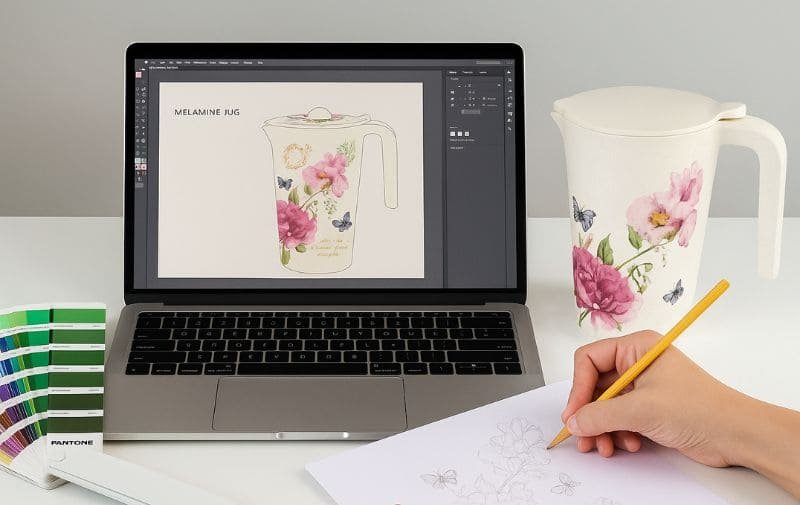
The Decal Fusion Process
The artwork isn’t applied after the fact. It’s integrated during the molding cycle. This is why the print is dishwasher-safe and won’t peel, fade, or chip off. The design is literally embedded within the melamine. When you’re discussing this with a supplier, asking about their “decal fusion process” signals that you’re a serious buyer.
Providing the Right Artwork
Because of this process, the quality of your artwork file is critical.
- File Format: You must provide your artwork in a vector format. The industry standards are Adobe Illustrator (.AI) or a vector-based .PDF. A simple .JPEG or .PNG file won’t work because it can’t be scaled perfectly without losing quality.
- Color Matching: For the most accurate colors, you need to provide Pantone (PMS) color codes. Computer screens vary, but a Pantone code is a universal standard that the factory’s printing department can match precisely.
- Full Sets: If you’re ordering a matching jug and cup set, you’ll need to provide separate artwork files scaled for the jug, the lid, and the cups to ensure the pattern looks right on each piece.
Tip: Always ask your supplier for the design template for your chosen mold. This will give you the exact dimensions and bleed areas you need for your artwork.
What Are the 5 Key Steps to Place Your Custom Melamine Jug Order?
Here is the exact process you will follow, from initial email to final delivery.
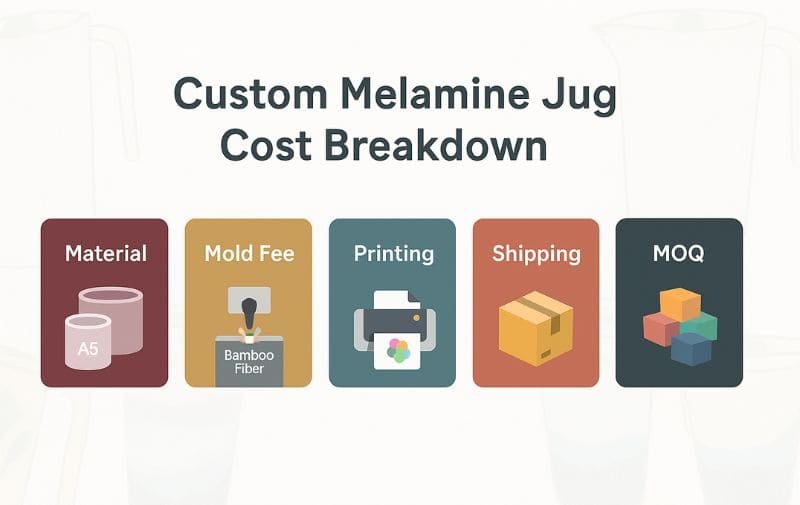
Step 1: Confirm Your Product Specifications & Design
This is the foundation of your order. You need to provide your supplier with a clear brief, including:
- Material: A5 Melamine or Bamboo Fiber?
- Model: Which standard mold will you use? Or are you requesting a quote for a new mold?
- Product Composition: Is it just a jug? Or a jug and cup set (e.g., 1 jug + 4 cups)?
- Artwork: Your custom design (logo, pattern, etc.).
Industry Tip: Provide your artwork in a vector format, such as an Adobe Illustrator (.AI) or vector .PDF file. This allows the factory to scale your design perfectly without losing quality. Crucially, provide Pantone (PMS) color codes for every color in your design to ensure the most accurate color matching possible.
Step 2: Understand MOQ and Get Your Quote
Once the supplier has your specifications, they will provide a quote. This is where you’ll encounter the Minimum Order Quantity (MOQ).
- The MOQ Rule: The standard MOQ is typically 3000 pieces (or 3000 sets).
- Why 3000? This isn’t an arbitrary number. It’s based on production efficiency. It represents the minimum batch of raw material that can be mixed, the most economical print run for the decals, and the cost of setting up the heavy machinery for your specific order. Running smaller quantities is highly inefficient and cost-prohibitive.
- Is it Flexible? Sometimes. If you are using a standard white jug and a simple logo, a good supplier partner might be able to combine your order with another, potentially allowing a slightly lower MOQ. It never hurts to ask, but you should plan and budget for the 3000-piece standard.
Step 3: Perfecting the Print – How Your Design Comes to Life
Your custom design is not painted or stamped onto the jug. It is permanently fused with it through a sophisticated process.
- Decal Printing: Your vector artwork is printed onto a special decal paper.
- Placement: During the molding process, a skilled worker carefully places this decal inside the open mold.
- Molding & Fusion: The raw melamine or bamboo fiber powder is added, and the mold is closed. Under immense heat and pressure, the powder liquefies, flows around the decal, and then cures. The decal permanently fuses with the surface of the jug.
This fusion process is why the print is food-safe, 100% dishwasher-safe, and will not peel, scratch, or fade over time.
Step 4: Choosing Your Packaging Strategy
Your packaging is the first physical interaction a customer has with your product. It’s a critical marketing tool.
- Neutral Packaging (Kraft or White Box): This is the most basic and lowest-cost option. It’s a plain box designed for protection during shipping.
- Ideal for: Restaurant supply, B2B wholesale where the client will repackage the item, or highly budget-conscious projects.
- Ideal for: Restaurant supply, B2B wholesale where the client will repackage the item, or highly budget-conscious projects.
- Full-Color Retail Box: A custom-designed, branded box.
- Ideal for: Products sold directly on retail shelves, online stores, or gift sets. The box becomes a primary sales tool, communicating your brand story and significantly increasing the perceived value. A beautiful box can easily double the appeal of the product inside.
- Ideal for: Products sold directly on retail shelves, online stores, or gift sets. The box becomes a primary sales tool, communicating your brand story and significantly increasing the perceived value. A beautiful box can easily double the appeal of the product inside.
Step 5: The Logistics Puzzle: Getting Jugs to Your Door
For anyone new to importing, shipping can be the biggest headache. You must understand your options.
- FOB (Free On Board): The supplier’s responsibility ends when they deliver the goods to the designated Chinese port. You are responsible for arranging and paying for ocean freight, insurance, customs clearance, duties, taxes, and final delivery. This is for experienced importers only.
- DDP (Delivered Duty Paid): This is the all-inclusive, door-to-door service you should ask for. The supplier manages the entire process: shipping, insurance, customs, and taxes. The price they quote is the final price to get the goods delivered to your warehouse or front door.
Peace of Mind Tip: For 99% of new buyers, DDP is the best choice. While the per-unit cost is higher than FOB, it eliminates risk, complexity, and unforeseen costs. It turns a complicated international logistics process into a simple shipping fee.
How Long Will the Entire Custom Order Process Realistically Take?
You’ve placed your order, now the waiting begins. But for how long? It’s crucial to have a realistic timeline for planning your inventory and marketing launches.
A typical custom melamine pitcher project takes about 2 to 4 months from initial order to final delivery, depending on whether a new mold is needed and the shipping destination.
Patience is a virtue in manufacturing! Rushing the process can lead to mistakes. It’s better to plan far in advance and give each stage the time it needs. I learned this the hard way on an early project where I promised a launch date before I fully understood the shipping timeline.
Here is a realistic breakdown of the timing for a typical project:
- New Mold Creation (if required): 14 – 21 days
- This happens first. If you’re using a standard mold, you can skip this.
- Sample Production & Approval: 5 – 7 days
- This includes the factory making the sample and you reviewing photos or waiting for it to ship.
- Mass Production (for 3000 sets): 21 – 28 days
- This is the main manufacturing window where the factory produces your full order.
- Ocean Shipping & Logistics: 30 – 55 days
- This is the biggest variable. Shipping from Asia to North America or Europe by sea can take a significant amount of time, including port processing and customs clearance.
- This is the biggest variable. Shipping from Asia to North America or Europe by sea can take a significant amount of time, including port processing and customs clearance.
Total Estimated Time (Standard Mold): ~56 – 90 days (approx. 2-3 months) Total Estimated Time (New Mold): ~70 – 105 days (approx. 2.5-3.5 months)
Tip: Always add a 2-week buffer to your timeline for unexpected delays in production or shipping. They can happen!
What Does a Custom Jug Order Really Cost?
When you get a quote, the “unit price” is just one part of the equation. To understand your true cost and set your retail pricing correctly, you need to see the full picture.
Your final landed cost per set is the sum of the unit price, any one-time mold fees, the custom packaging cost, and all shipping, insurance, duty, and tax charges.
To avoid any nasty surprises, you need to demystify your costs from the beginning. A good supplier will be transparent and provide an itemized quote so you can see exactly what you’re paying for. Don’t be shy about asking for this breakdown.
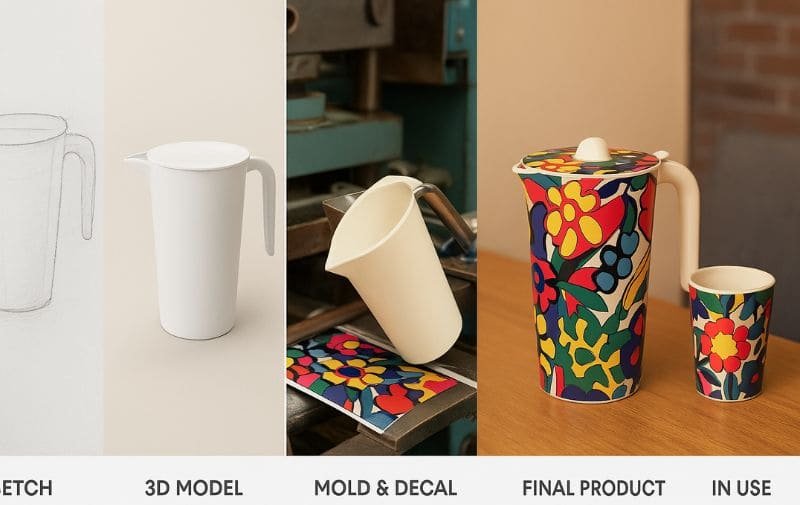
Here are the components that make up your total investment:
- Unit Price: This is the base cost for producing one jug (or one jug and cup set). It covers the raw materials and the factory’s labor and overhead.
- Mold Fee (One-Time Cost): If you created a new mold, this is a one-time investment. To calculate its impact on your unit cost, you can amortize it. For example, a $1,200 mold fee on a 3000-piece order adds $0.40 to each unit’s cost for that first order.
- Custom Packaging Cost: A full-color retail box will add a significant amount to your unit price compared to a plain box. Get quotes for both so you can see the difference.
- Shipping & Logistics Costs: This includes all the charges to get the products from the factory to your door. If you use DDP, all these costs (shipping, insurance, customs, duties, taxes) will be bundled into one per-unit price, which makes budgeting much easier.
By adding all these up, you get your “landed cost per unit,” which is the true cost of getting one finished product into your hands, ready to sell.
Final Checklist: Are You Ready to Order?
Before you send that inquiry email, run through this checklist:
- Brand Identity: Do I know if I want a glossy/premium (A5 Melamine) or matte/natural (Bamboo Fiber) look?
- Design: Is my artwork ready in a vector format (.AI or .PDF)?
- Color: Do I have the Pantone (PMS) color codes for my design?
- Budget: Have I budgeted for a 3000-piece MOQ?
- Uniqueness: Will a standard mold work, or do I need to budget for a custom mold?
- Packaging: Do I need a basic shipping box or a full-color retail box?
- Logistics: Will I ask for a DDP (door-to-door) quote to simplify shipping?
- Timeline: Have I planned for a 3-4 month lead time?
Is a Custom Melamine Jug Right for Your Business?
These jugs are incredibly versatile, but are they a good fit for your specific brand or business? Let’s look at where they shine the brightest.
Custom melamine jugs are perfect for businesses in the home goods, outdoor/patio, restaurant/cafe, and gift markets. Their durability and branding potential make them a versatile and high-value product.
A custom jug isn’t just a container for drinks; it’s a statement piece. It can anchor a whole collection or elevate a dining experience. I’ve seen them succeed in so many different contexts.
Key Target Markets:
- Home & Kitchenware Brands: A custom jug and cup set is a fantastic centerpiece for a new dinnerware collection. It’s perfect for summer BBQ promotions, serving family meals, or as a staple in a kitchen essentials line.
- Outdoor & Patio Stores: For this market, melamine’s main selling point is being a stylish and virtually unbreakable alternative to glass. It’s ideal for poolside, patio dining, camping, and boating.
- Restaurants, Cafes, and Hotels: A branded jug is a functional and elegant way to serve table water, iced tea, or juice. It enhances the ambiance, reinforces the brand, and is durable enough to withstand constant commercial use and washing.
- Promotional & Gift Market: A beautifully boxed jug set makes an excellent corporate gift, a housewarming present, or a holiday special. The high perceived value and utility make it a memorable item.
If your business falls into one of these categories, a custom melamine jug could be a powerful addition to your product offering.
Frequently Asked Questions (FAQ)
Q1: Can I order a physical sample before committing to 3000 pieces?
A: Absolutely. Once you’ve agreed on the quote, the supplier will create a “pre-production sample” with your custom print. You will receive photos or even the physical sample for approval before they begin mass production. There is usually a small fee for this, which is often credited back if you proceed with the full order.
Q2: Can I have a different color lid or handle from the jug body?
A: Yes! This is a common customization request. Because the parts are molded separately, you can specify different colors for the jug body, lid, and even the handle. This may slightly affect the price, so be sure to include this detail in your initial request.
Q3: What if I need fewer than 3000 jugs?
A: For a fully custom print, this is very difficult due to production minimums. Your best alternative is to ask the supplier if they have any in-stock, plain-colored jugs (like white, black, or gray) that you could purchase in smaller quantities and then have customized locally with a sticker or pad print (note: this will not be as durable as a fused decal).
Q4: How do I choose a reliable custom melamine jug supplier?
A: Look for a supplier with extensive experience exporting to your target market (e.g., EU, USA), as they will be familiar with safety standards like LFGB and FDA. Ask for compliance certificates. A good supplier will communicate clearly, offer DDP shipping, and be transparent about their process, including the decal fusion technique.
Recommended Internal & External Links:
- See Examples of Custom Jug & Cup Sets
- What is DDP Shipping? (Incoterms Explained) – A guide to understanding shipping terms.

